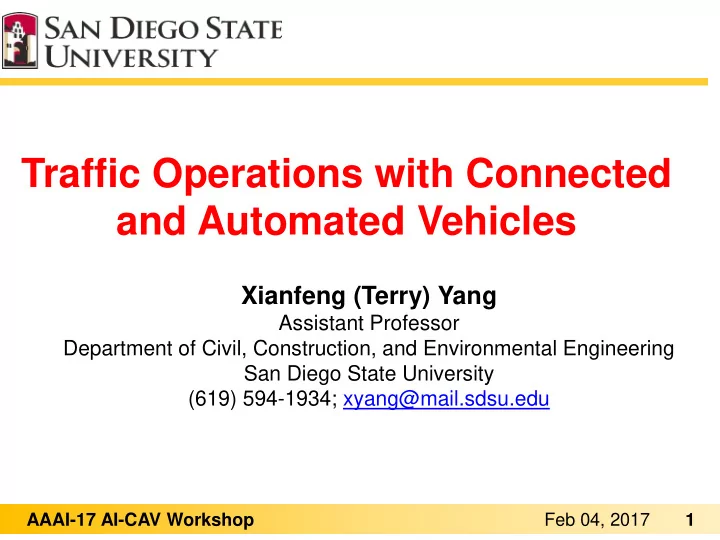

Traffic Operations with Connected and Automated Vehicles Xianfeng (Terry) Yang Assistant Professor Department of Civil, Construction, and Environmental Engineering San Diego State University (619) 594-1934; xyang@mail.sdsu.edu AAAI-17 AI-CAV Workshop Feb 04, 2017 1
This is a FUTURE CAR • Automotive control • Lane changing warning and control • Self driving • Vehicle platooning • Forward collision avoidance • Providing optimal path • ECO-Approach and departure at intersections • Dynamic speed Harmonization • Advanced traveler information • Queue warning • Etc. AAAI-17 AI-CAV Workshop Feb 04, 2017 2 2
Automated Vehicles Warning and Advisory Partly Automatic Fully Automatic Sensor-based Automated Vehicle Fully Autonomous Vehicle Sensor-based Technologies AAAI-17 AI-CAV Workshop Feb 04, 2017 3
Connected Vehicle • Connectivity technologies • DSRC • WAVE • 3G / 4G • DMB • Communication types • V2X : V2V, V2I, V2P, V2B…… • Car2X • Etc. Connected Automated Vehicle Connectivity Technologies ( Connected Vehicle ) AAAI-17 AI-CAV Workshop Feb 04, 2017 4
Why we need Connected Vehicle Technologies? AAAI-17 AI-CAV Workshop Feb 04, 2017 5
Why do we need CV technologies https://youtu.be/q58DzXQ8ae4?t=2m9s • Safety https://youtu.be/2Ac2lgo7Opo?t=37s – Intersection Movement Assist AAAI-17 AI-CAV Workshop Feb 04, 2017 6 6
Why do we need CV technologies • Mobility – R.E.S.C.U.M.E • Response, Emergency Staging and Communications, Uniform Management, and Evacuation AAAI-17 AI-CAV Workshop Feb 04, 2017 7 7 7
Why do we need CV technologies • Mobility – Platooning AAAI-17 AI-CAV Workshop Feb 04, 2017 8 8
What will happen with AVs only? • AVs are often designed with conservative control functions (Safety is always the priority). • Within mixed traffic flow (AVs and non-AVs), AVs may become the “Moving Bottleneck” which will increase the total network delay and reduce safety performance. • How about 100% AVs on the roads but without CV technologies? AAAI-17 AI-CAV Workshop Feb 04, 2017 9
Cooperative Adaptive Cruise Control • Adaptive Cruise Control (ACC) technology automatically adjust the vehicle speed and distance to that of a target vehicle. ACC uses a long range radar sensor to detect a target vehicle up to 200 meters in front and automatically adjusts the ACC vehicle speed and gap accordingly. • Adaptive cruise control (ACC) systems can gain enhanced performance by adding vehicle–vehicle wireless communication to provide additional information to augment range sensor data, leading to cooperative ACC (CACC). AAAI-17 AI-CAV Workshop Feb 04, 2017 10
CACC v.s. ACC – Field Test MILANÉS et al. (2014): COOPERATIVE ADAPTIVE CRUISE CONTROL IN REAL TRAFFIC SITUATIONS, IEEE TRANSACTIONS ON INTELLIGENT TRANSPORTATION SYSTEMS, VOL. 15, NO. 1, pp. 296-305. AAAI-17 AI-CAV Workshop Feb 04, 2017 11
CACC v.s. ACC ACC CACC AAAI-17 AI-CAV Workshop Feb 04, 2017 12
How to make the CAV-based system more efficient? (e.g., Data Collection) AAAI-17 AI-CAV Workshop Feb 04, 2017 13
Motivations • It is still challenging to deploy V2V system in practice, because connected vehicles need to share roads with other isolated (non-connected) vehicles; • Camera sensors can provide rich imagery descriptions of the surrounding environments of the host vehicles; • To access the traffic statuses of isolated vehicles, an effective but affordable way is to enhance V2V-equipped vehicles with camera sensors; AAAI-17 AI-CAV Workshop Feb 04, 2017 14
System Demonstration • With camera on connected vehicles, the system will first conduct video processing and extract the information of perceived vehicles such as their speeds, locations, and driving behaviors; • Through V2V platform, isolated vehicles are perceived and then linked with connected vehicles so as to form a dynamic Ad-Hoc Sensor Network which includes all vehicle information. Connected Vehicle with Vision Support Non-connected Vehicle AAAI-17 AI-CAV Workshop Feb 04, 2017 15
Field Demo Test • Four vehicles equipped with camera sensors are tested on I-15, San Diego. AAAI-17 AI-CAV Workshop Feb 04, 2017 16
Step 1: Video Processing on each connected vehicle AAAI-17 AI-CAV Workshop Feb 04, 2017 17
Step 2: Construction of dynamic Ad-Hoc Sensor Network Car C Car D Car B Car A AAAI-17 AI-CAV Workshop Feb 04, 2017 18
Step 2: Construction of dynamic Ad-Hoc Sensor Network AAAI-17 AI-CAV Workshop Feb 04, 2017 19
Traffic Signal Control at Intersections under CAV Environment AAAI-17 AI-CAV Workshop Feb 04, 2017 20
The fundamental questions • Will we even need traffic signals in the future? – What happens when the volume increases? – Do we see emergent behavior that mimics traffic signals? • How will we transition during market adoption? AAAI-17 AI-CAV Workshop Feb 04, 2017 21
CAV Traffic Signal Research Needs • Categories of Research Needs - – Network Level Control Considerations • More than a collection of intersection, heterogeneous path flows, … – User capabilities/characteristics • Vehicle, Pedestrians, Trucks, Buses, Bicycles, Motorcycles,… – Institutional and Social Issues • Culture, cooperative behaviors – Traffic flow theory • Changes in vehicle behaviors (saturation flow, headway, acceleration, startup lost time, sneakers, …..) – Application scenarios • Managed Lanes for CAV, Multi Modal, integration of apps – speed harmonization, eco-driving, …. AAAI-17 AI-CAV Workshop Feb 04, 2017 22
CAV Traffic Signal Research Needs – Control algorithms/strategies • Trajectory control, multi modal, priority, path based, vehicle dynamics, – Human factors • Passenger/driver limits – acceleration, gaps, … – Infrastructure adaptation • Geometric opportunities (change lane usage/assignment, move the stop bar,….) – Evolution from today to next generation • Levels of Automation (Vehicle Automation, but for signals) – Impact of shared mobility in traffic control • Large fleets of vehicles operating with a common goal • Transportation network service providers AAAI-17 AI-CAV Workshop Feb 04, 2017 23
Thanks for your attention Xianfeng (Terry) Yang (619) 594-1934 xyang@mail.sdsu.edu AAAI-17 AI-CAV Workshop Feb 04, 2017 24
Recommend
More recommend